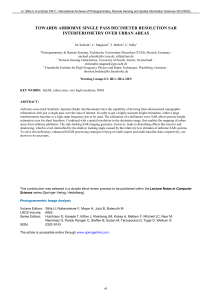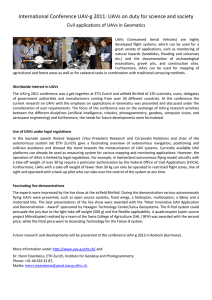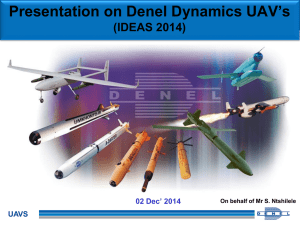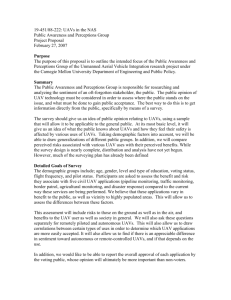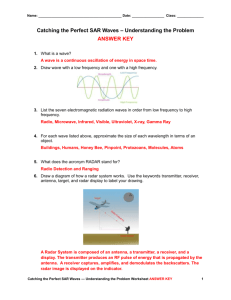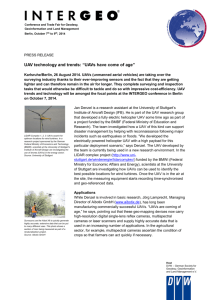Executive Summary SARpe
advertisement
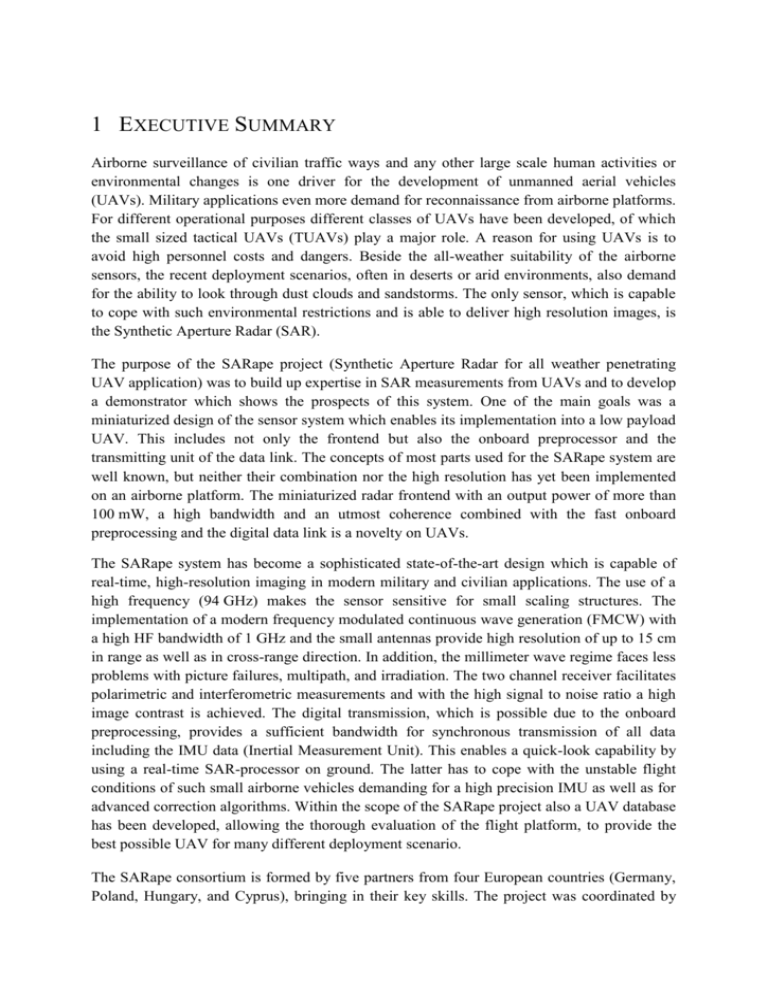
1 EXECUTIVE SUMMARY Airborne surveillance of civilian traffic ways and any other large scale human activities or environmental changes is one driver for the development of unmanned aerial vehicles (UAVs). Military applications even more demand for reconnaissance from airborne platforms. For different operational purposes different classes of UAVs have been developed, of which the small sized tactical UAVs (TUAVs) play a major role. A reason for using UAVs is to avoid high personnel costs and dangers. Beside the all-weather suitability of the airborne sensors, the recent deployment scenarios, often in deserts or arid environments, also demand for the ability to look through dust clouds and sandstorms. The only sensor, which is capable to cope with such environmental restrictions and is able to deliver high resolution images, is the Synthetic Aperture Radar (SAR). The purpose of the SARape project (Synthetic Aperture Radar for all weather penetrating UAV application) was to build up expertise in SAR measurements from UAVs and to develop a demonstrator which shows the prospects of this system. One of the main goals was a miniaturized design of the sensor system which enables its implementation into a low payload UAV. This includes not only the frontend but also the onboard preprocessor and the transmitting unit of the data link. The concepts of most parts used for the SARape system are well known, but neither their combination nor the high resolution has yet been implemented on an airborne platform. The miniaturized radar frontend with an output power of more than 100 mW, a high bandwidth and an utmost coherence combined with the fast onboard preprocessing and the digital data link is a novelty on UAVs. The SARape system has become a sophisticated state-of-the-art design which is capable of real-time, high-resolution imaging in modern military and civilian applications. The use of a high frequency (94 GHz) makes the sensor sensitive for small scaling structures. The implementation of a modern frequency modulated continuous wave generation (FMCW) with a high HF bandwidth of 1 GHz and the small antennas provide high resolution of up to 15 cm in range as well as in cross-range direction. In addition, the millimeter wave regime faces less problems with picture failures, multipath, and irradiation. The two channel receiver facilitates polarimetric and interferometric measurements and with the high signal to noise ratio a high image contrast is achieved. The digital transmission, which is possible due to the onboard preprocessing, provides a sufficient bandwidth for synchronous transmission of all data including the IMU data (Inertial Measurement Unit). This enables a quick-look capability by using a real-time SAR-processor on ground. The latter has to cope with the unstable flight conditions of such small airborne vehicles demanding for a high precision IMU as well as for advanced correction algorithms. Within the scope of the SARape project also a UAV database has been developed, allowing the thorough evaluation of the flight platform, to provide the best possible UAV for many different deployment scenario. The SARape consortium is formed by five partners from four European countries (Germany, Poland, Hungary, and Cyprus), bringing in their key skills. The project was coordinated by the European Defense Agency (EDA). The consortium lead was with the Fraunhofer FHR (DE) which was also responsible for the system concept, hardware integration and design of the radar frontend. The part of Fraunhofer IAF (DE) was the design and fabrication of the HF components. Pro Patria Electronics (HU) provided the onboard preprocessor and the telemetry unit was within the responsibility of the University of Cyprus (CY). The team from the Warsaw University of Technology (PL) developed the SAR algorithms. SLOT Consulting (HU) was responsible for the programming of the UAV database and the dissemination work. Further information on the SARape project is available via www.project-sarape.eu. The integration and trials conducted with the SARape system demonstrated its operability. All units, radar frontend, preprocessor, and telemetry data link performed according to specifications and better. Real-time SAR images were processed with great success up to a distance of 4.5 km between aircraft (transmitter) and ground station (receiver). They revealed many details of the observed scene with brilliant image contrast and high resolution (see Figures 1 and 2). Also different radar modes, concerning bandwidth (range resolution) and swath-width, were successfully tested. Furthermore, a small portion of work was dedicated to the interferometric analysis with promising first results. Fig. 1: SAR image of the Fraunhofer FHR site and blow-up of the scene (right). Fig. 2: SAR image of the Moenchsheide airfield and blow-up of the scene (right).
